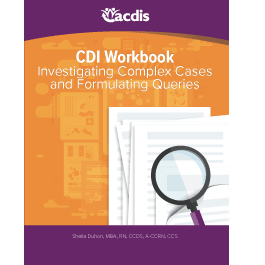Book excerpt: The “TRIC” to query success
November 26, 2018
CDI Blog - Volume 11, Issue 234

Complex Cases and
Formulating Queries
By Sheila Duhon, MBA, RN, CCDS, A-CCRN, CCS
The TRIC tactic to queries provides a quick and systematic approach that ensures the necessary components of the query are present and displayed in a compliant manner to the provider. TRIC is the acronym that stands for these four components: treatment, risk, indicators, and compliant question.
- Treatment: Coding guidelines mandate that any condition coded and reported must be relevant to the encounter for care (see the 2018 Official Guidelines for Coding and Reporting). A condition must be monitored, treated, and evaluated, require increased allocation of nursing resources, or require an extended stay. Therefore, when a query is posed to the provider, there should exist, and be documented in the query, clear and precise indicators of treatment, monitoring, evaluation, increased allocation of nursing resources, or extended-stay requirements. Findings that are incidental and insignificant are not considered relevant to the encounter and should not be used as documentation in a query. Additionally, such findings should not be coded.
- Risk: Risk refers to the relevance of the diagnosis to the patient and the encounter for care. Signs and symptoms can be brought into account when assessing risk. For example, a diagnosis of pneumonia in an elderly bed-bound patient with a history of a cerebrovascular accident and a diagnosis of dysphagia with an impaired gag reflex possesses a risk for the more complex diagnosis of aspiration pneumonia.
- Indicators: Indicators refer to the clinical indicators that comprise the overall clinical picture inclusive of the risk, treatment, response to intervention, and test findings that are taken into account during the physician’s medical decision-making process and assessment to arrive at a diagnosis. A query should contain sufficient clinical indicators that would support (or rule out) a diagnosis. Therefore, presenting a single clinical indicator, such as an abnormal laboratory test finding without corresponding signs, symptoms, treatment, or response to treatment, would likely render a query noncompliant and perhaps leading in nature.
- Compliant question: The compliant question should always be clear and succinct. Always be professional, courteous, and include your contact information so that the physician may contact you for any questions he or she may have about the query or other documentation issues. If a physician responds to a query by countering and asking what you’re asking, you may not have stated your question clearly and succinctly. If the question was clear and succinct, then study the other components of the query. Were the clinical indicators aligned with the condition(s) of the query focus? Was there risk to the patient associated with the focus of the query? Was there correlation of treatments and interventions to the condition? If you can answer in the negative to any of these questions, you may want to analyze the query components and practice more effective query writing.
Editor’s note: This article is an excerpt from CDI Workbook: Investigating Complex Cases and Formulating Queries.
